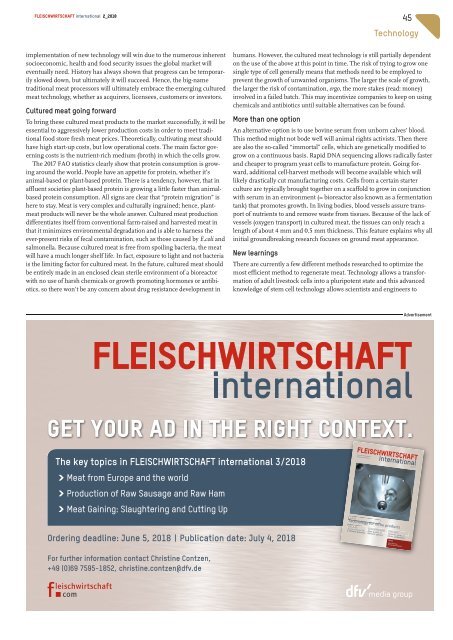FLEISCHWIRTSCHAFT international 2/2018
Create successful ePaper yourself
Turn your PDF publications into a flip-book with our unique Google optimized e-Paper software.
Fleischwirtschaft <strong>international</strong> 2_<strong>2018</strong><br />
45<br />
Technology<br />
implementation of new technology will win due to the numerous inherent<br />
socioeconomic, health and food security issues the global market will<br />
eventually need. History has always shown that progress can be temporarily<br />
slowed down, but ultimately it will succeed. Hence, the bigname<br />
traditional meat processors will ultimately embrace the emerging cultured<br />
meat technology,whether as acquirers, licensees, customers or investors.<br />
Cultured meat going forward<br />
To bring these cultured meat products to the market successfully,itwill be<br />
essential to aggressively lower production costs in order to meet traditional<br />
food store fresh meat prices. Theoretically,cultivating meat should<br />
have high startup costs, but low operational costs. The main factor governing<br />
costs is the nutrientrich medium (broth) in which the cells grow.<br />
The 2017 FAO statistics clearly show that protein consumption is growing<br />
around the world. People have an appetite for protein, whether it’s<br />
animalbased or plantbased protein. There is atendency,however,that in<br />
affluent societies plantbased protein is growing alittle faster than animalbased<br />
protein consumption. All signs are clear that “protein migration” is<br />
here to stay.Meat is very complex and culturally ingrained; hence, plantmeat<br />
products will never be the whole answer.Cultured meat production<br />
differentiates itself from conventional farmraised and harvested meat in<br />
that it minimizes environmental degradation and is able to harness the<br />
everpresent risks of fecal contamination, such as those caused by E.coli and<br />
salmonella. Because cultured meat is free from spoiling bacteria, the meat<br />
will have amuch longer shelf life. In fact, exposure to light and not bacteria<br />
is the limiting factor for cultured meat. In the future, cultured meat should<br />
be entirely made in an enclosed clean sterile environment of abioreactor<br />
with no use of harsh chemicals or growth promoting hormones or antibiotics,<br />
so there won’t be any concern about drug resistance development in<br />
humans. However,the cultured meat technology is still partially dependent<br />
on the use of the above at this point in time. The risk of trying to grow one<br />
single type of cell generally means that methods need to be employed to<br />
prevent the growth of unwanted organisms. The larger the scale of growth,<br />
the larger the risk of contamination, ergo, the more stakes (read: money)<br />
involved in afailed batch. This may incentivize companies to keep on using<br />
chemicals and antibiotics until suitable alternatives can be found.<br />
More than one option<br />
An alternative option is to use bovine serum from unborn calves’ blood.<br />
This method might not bode well will animal rights activists. Then there<br />
are also the socalled “immortal”cells, which are genetically modified to<br />
grow on acontinuous basis. Rapid DNA sequencing allows radically faster<br />
and cheaper to program yeast cells to manufacture protein. Going forward,<br />
additional cellharvest methods will become available which will<br />
likely drastically cut manufacturing costs. Cells from acertain starter<br />
culture are typically brought together on ascaffold to grow in conjunction<br />
with serum in an environment (= bioreactor also known as afermentation<br />
tank) that promotes growth. In living bodies, blood vessels assure transport<br />
of nutrients to and remove waste from tissues. Because of the lack of<br />
vessels (oxygen transport) in cultured meat, the tissues can only reach a<br />
length of about 4mmand 0.5 mm thickness. This feature explains why all<br />
initial groundbreaking research focuses on ground meat appearance.<br />
New learnings<br />
There are currently afew different methods researched to optimize the<br />
most efficient method to regenerate meat. Technology allows atransformation<br />
of adult livestock cells into apluripotent state and this advanced<br />
knowledge of stem cell technology allows scientists and engineers to<br />
Advertisement

















